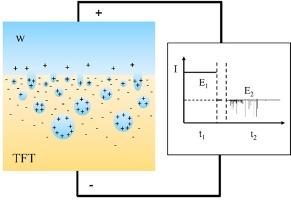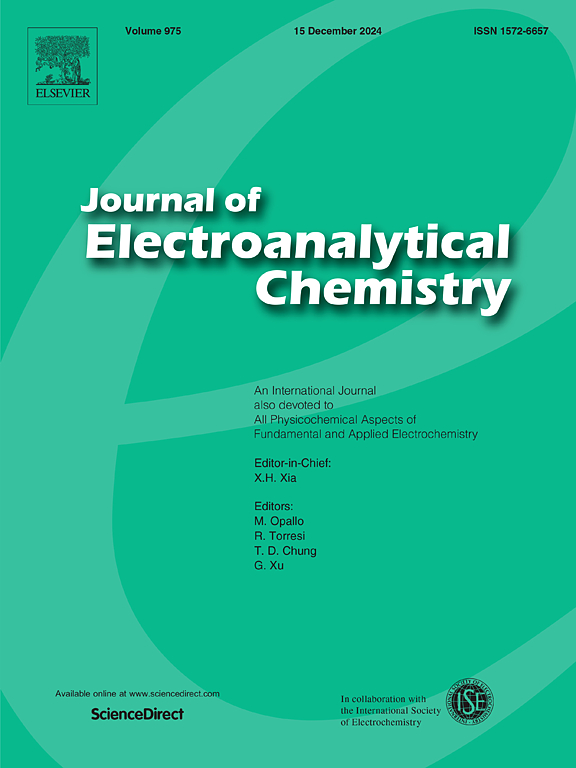在微水/三氟甲苯界面使用单实体电化学研究金属-土离子体的生成-融合策略
IF 4.1
3区 化学
Q1 CHEMISTRY, ANALYTICAL
引用次数: 0
摘要
离子体是水合阳离子或阴离子在有机相中通过自发组装离子双层膜形成的水团/水滴。由单价离子(即 Li+、Na+、K+、Cl- 等)形成的离子体已得到深入研究。在此,利用单实体电化学(SEE)发现了有机溶液中的单纳米水簇(即离子体),它是由金属土阳离子(即 Mg2+、Ca2+、Ba2+)转移到有机亲脂电解质中形成的。在研究水/α,α,α-三氟甲苯(w/TFT)界面上的单个 Mg2+-ionosomes 时,采用了涉及两步恒电位计时器的生成-融合策略。在激发电势迫使亲水离子进入有机相后,记录了一连串电流尖峰,其中包含综合电荷、频率和持续时间等信息,从而深入了解了离子体。对各种变量进行了深入研究,包括激发电位、激发时间、记录电位、应用 w/TFT 界面的大小、离子种类和浓度。这些结果表明(1) 揭示了单个 Mg2+ 离子体的大小;(2) 肉质形成的离子体主要位于 w/TFT 界面的有机侧,而不是扩散到有机体中;(3) 当界面减小时,形成的离子体减少,离子体的大小减小;(4)单个离子体携带的平均电荷与单个阳离子的电荷密度呈正相关;(5)通过交替记录电位,揭示了 Mg2+-离子体的负 zeta 电位;(6)当水溶液中仅含有 2 μmol-L-1 Mg2+ 时,即可形成 Mg2+-离子体。这项工作通过 SEE 对有机相中的水合金属土离子团簇进行了深入研究,并从电化学角度对界面电双层进行了深入探讨。除了促进对离子体的了解,这一策略还为鉴定高纯水提供了潜在应用。本文章由计算机程序翻译,如有差异,请以英文原文为准。

Generation-fusion strategy in metal-earth ionosome investigation using single-entity electrochemistry at the micro-water/trifluorotoluene interface
Ionosomes are water clusters/droplets formed in an organic phase via the spontaneous assembly of ionic bilayers by hydrated cations or anions. The ionosomes formed by monovalent ions, i.e., Li+, Na+, K+, Cl−, etc., have been thoroughly investigated. Herein, single nanowater clusters (viz. ionosomes) in organic solutions, which are formed by the transfer of metal earth cations (i.e., Mg2+, Ca2+, Ba2+) into organic lipophilic electrolytes, were discovered using single-entity electrochemistry (SEE). The generation-fusion strategy involving two-step potentiostatic chronoamperometry was applied to investigate single Mg2+-ionosomes at the water/α,α,α-trifluorotoluene (w/TFT) interface. After an exciting potential forced the hydrophilic ion into the organic phase, a train of current spikes with information on the integrated charges, frequency, and duration were recorded to gain insight into the ionosomes. Variates were thoroughly investigated, including the exciting potential, exciting time, recording potential, size of the applied w/TFT interface, ion species, and concentration. These results suggest that: (1) the size of a single Mg2+-ionosome was revealed; (2) the fleshly formed ionosomes are mainly located on the organic side of the w/TFT interfacial surface instead of diffusing into the organic bulk; (3) when the interface decreases, fewer ionosomes form, and the size of the ionosomes decreases; (4) the mean charge carried by a single ionosome is positively related to the charge density of a single cation; (5) by alternating the recording potential, the negative zeta potential of Mg2+-ionosomes was revealed; (6) Mg2+-ionosomes can form when the aqueous solution contains only 2 μmol·L−1 Mg2+. This work thoroughly investigated hydrated metal earth ion clusters in the organic phase via SEE and provides insights into the interface electric double layer from the electrochemistry perspective. In addition to promoting the understanding of ionosomes, this strategy can provide potential applications to identify high-purity water.
求助全文
通过发布文献求助,成功后即可免费获取论文全文。
去求助
来源期刊
CiteScore
7.80
自引率
6.70%
发文量
912
审稿时长
2.4 months
期刊介绍:
The Journal of Electroanalytical Chemistry is the foremost international journal devoted to the interdisciplinary subject of electrochemistry in all its aspects, theoretical as well as applied.
Electrochemistry is a wide ranging area that is in a state of continuous evolution. Rather than compiling a long list of topics covered by the Journal, the editors would like to draw particular attention to the key issues of novelty, topicality and quality. Papers should present new and interesting electrochemical science in a way that is accessible to the reader. The presentation and discussion should be at a level that is consistent with the international status of the Journal. Reports describing the application of well-established techniques to problems that are essentially technical will not be accepted. Similarly, papers that report observations but fail to provide adequate interpretation will be rejected by the Editors. Papers dealing with technical electrochemistry should be submitted to other specialist journals unless the authors can show that their work provides substantially new insights into electrochemical processes.

 求助内容:
求助内容: 应助结果提醒方式:
应助结果提醒方式:


